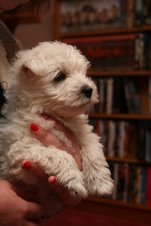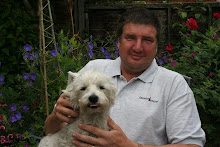 |
| An early breakfast for Mary and Isabelle |
Our Berkshire pigs, Mary and Izzy (Isabelle) reach the 20 weeks stage and I get back round them with the tape-measure to estimate their weights. They are 45 and 46 kgs respectively and looking fine and fit. These weights are way, way below what the Tamworths achieved last year (that was more like 70 kg at this stage) but we are happy and this is deliberate. Last year was our first year and I must admit I
poured food into them, ignoring the advice from our 'bible' (Liz Shankland's "Haynes Pig Manual") and giving in to their squealing, raucous demands that I continue the three meals a day, and 800g+ of feed every meal. I scooped food using a 1 litre yogurt tub and I'm sure they got a scoop each at each meal.
 |
Tamworth (2014) pork chop with a good
2cm covering of fat. |
The 'bible' says that up to 16 weeks age you increase feeding so that the portion matches roughly 1/10 of age in weeks (i.e. 1.2 kg per day at 12 weeks) but that after 16 weeks you drop down to a maintenance diet of 1.4 kg till slaughter. This for 'pork' animals rather than baconners. We know from our meat from last year that my over-feeding proves this spot-on. The chops have a good 2 cm covering of fat at least which other than what you can feed to the birds or dry-roast (skin) as dog treats, would be waste. A chop which weighs 288 g includes 92 g of fat and skin, so if you trim that off, you are losing 32% of the weight.
 |
A giant scabious? This fella is 4 feet tall and has flowers two
and a half inches broad. |
We can see why, in these days when people do not want to eat all that fat because they are no longer doing manual labour to burn off calories, the commercial boys go for a much more lean, middle-white style of pig.
 |
Went shopping and 'accidentally' bought
this new penstemon for the tubs in the yard |
Did we really produce 90 kg animals and get 70 kg of meat back from the butcher? I don't think so with all that "waste". The 32% will not apply all across the carcass of course, but even so, I certainly spent more money on pig nuts than I should have or needed to. So this year, Mary and Isabelle are on a strict, 'Shankland' diet. I never started the three-meals-a-day (nuts) habit. They have only ever had a piece of fruit each at lunchtime, an apple or a peach cut up for example. In the morning and evening they get a strict one-and-a-half tubs (1.4 kg) of meal (plus more fruit) split between them, so that they get their 1.4 kg each per day. Guess what - thay are still perfectly fit and healthy and they do not squeal for food in between meals and annoy me from half way across the garden. They may only be 55-60 kg at 6 months, instead of 90 kg but we hope they will still look a decent sized animal and should have a much thinner covering of fat. "Ripped" like an athlete, maybe, rather than blubbered up like a beached beluga whale? We'll see.
 |
| Newly hatched turkey, still damp from the egg. |
When I last posted, we were still waiting for the cheep of a pipping turkey egg or two from the incubator, but not very hopeful because of our mid-term power cut. Well we got two babies over Monday night into Tuesday; the remaining three eggs are awfully quiet. That, we have found, seems to be the way of it with incubator hatches of small batches. Charlotte tells us that they all tend to come out together, encouraged to extra efforts by the cheeping and nudging of their neighbours moving eggs about as they wriggle around inside. They end up, if they are able, synchronised and you don't really get any stragglers - you can leave the unhatched eggs for days more but to no avail. We presume this is an adaptation which would work for ground nesting birds, so that the whole new family could be up and finding food, not sitting around unfed while the Tail-End Charlies hatched. We don't hold out much hope for eggs 3,4 and 5.
 |
Non-skid place-mats from an old folks home, now used as
non-skid floor for new-hatch turkeys. |
Many thanks, too, to our new chum Sue, who gave us some non-skid rubber mesh pads to try out. These soft pads are really placemats as used in old folks' homes to stop crockery skidding about but turkeys when newly hatched are notoriously wobbly on their legs. They struggle to find enough grip on the plastic floor of an incubator to flip themselves upright and then get their feet under them enough to stand up. We have seen this. They thrash around flat on their stomachs, flailing like a frog and there is a risk of the poultry-keeper culling them out as crippled failures.
 |
| The first batch of turkeys are now 5 weeks old and getting huge. |
On this rubber mat, as long as they can get up the right way, they are up on their feet and walking about in no time. They do still teeter and wobble like drunks or baby humans and occasionally fall onto their backs but if you rescue them from that a couple of times, they soon get the idea. The mat is also infinitely washable (as you'd expect from old folks' home ware) and, because you do not need to bed the birds on shredded straw or wood shavings (which they kick into the waterers), it is a lot easier to keep their water supply clean and fresh.
 |
Red Valerian nicked from a river-side wall
in town last year as a root "cutting". |
The next job is to teach them to peck up food. I'm not entirely sure I
need to do this; they may learn it by themselves from folk-memory. I enjoy it though and it gets them used to me. I sit in by them with a chopstick either "pecking" at the food, dipping the end in water and tapping this onto the side of their beak, or trying to convey bits of food to them stuck to the end. They start first to peck at the chopstick but then get impatient with me and peck instead at the bits I am 'pecking' in the bowl and, lo, tukeys eating! That's the theory anyway. These most recent 2 seem to be playing games with me. They profess complete bamboozlement, looking at me, then the chopstick, shaking their heads vigourously to shake off any food they have got on their beak by mistake. They slope off back under their nice warm 'electric hen' as if bored.
 |
"About Bloody Time!" exclaimed Liz when she finally got this
Philadelphus to flower after many years of trying and three
different 'blind' bushes. |
I wonder if they will ever learn, but then I come downstairs and I can hear, through the floor boards, the sounds of vigorous activity above, like a plague of rats has taken over the spare bedroom. Surely that is the tap-tap of efficient pecking? Sure enough, when I next visit the bowl seems very empty and the bamboozled birds are looking up at me as if to say "What food? Wasn't us!" No matter. New hatch birds get a 24-48 hour breathing space before they must eat on account of the yolk re-absorbed into their abdomen just prior to hatch, so their failure to eat on Tuesday or Wednesday would not have been a problem. They need to eat (and drink) today, mind, so they can do it sneakily upstairs if that is their thing.
 |
A good sized thyme grows in the side
of our keyhole bed. |
All being well, Liz returns to the fold today after her most recent 'Ministering Angel' trip to Silverwoods and I 'd rather have two well fed birds to show off, than 2 starvelings.












2 comments:
The plant is indeed a yellow scabious, but it didn't come from us.
Thank you for that. Perhaps the person who gave us the seed or plant is a reader and can solve this mystery.
Post a Comment